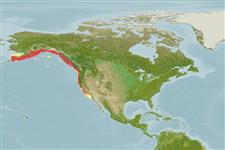Elasmobranchii (tubarões e raias) (sharks and rays) >
Rajiformes (Skates and rays) >
Rajidae (Skates)
Etymology: Beringraja: Named for the Bering Sea, though to be the origin of the two species in this genus.; binoculata: From the Latin 'bi' meaning two and 'oculata' meaning eyed - referring to the arrangement of pigment on the pectoral fin bases (Ref. 6885).
More on author: Girard.
Environment: milieu / climate zone / depth range / distribution range
Ecologia
marinhas demersal; intervalo de profundidade 3 - 800 m (Ref. 6793), usually 3 - 110 m (Ref. 2850). Temperate; 61°N - 31°N, 165°W - 117°W (Ref. 55279)
North Pacific: Glubokaya Bay, Cape Navarin, and Stalemate Bank to Cedros Island, Baja California, Mexico.
Length at first maturity / Tamanho / Peso / Idade
Maturity: Lm ?, range 130 - ? cm
Max length : 244 cm TL macho/indeterminado; (Ref. 2850); common length : 180 cm TL macho/indeterminado; (Ref. 2850); peso máx. Publicado: 91.0 kg (Ref. 2850)
Espinhos dorsais (total): 0; Raios dorsais moles (total): 0; Espinhos anais 0; Raios anais moles: 0. Dorsal fins well back on tail, small; caudal and anal fins absent; pectorals broad, attached to snout and incorporated with body; pelvic fins large, moderately concave on free margins (Ref. 6885). Posterior sides of tail with a small fleshy keel on either side (Ref. 6885).
Largest skate in North America (Ref. 2850). Feed on crustaceans and fishes (Ref. 6885). Oviparous. Distinct pairing with embrace. Young may tend to follow large objects, such as their mother (Ref. 205). Young hatch at 18-23 cm TL (Ref. 114953). Eggs are oblong capsules with stiff pointed horns at the corners deposited in sandy or muddy flats (Ref. 205). Egg capsules are 22.8-30.5 cm long and 11.0-19.4 cm wide (Ref. 41249, 41300, 41357). Pectoral fins utilized for human consumption (Ref. 2850). Marketed fresh and frozen; eaten fried and baked (Ref. 9988).
Life cycle and mating behavior
Maturidade | Reprodução | Desova | Ovos | Fecundidade | Larvas
Up to 7 embryos per egg case (Ref. 2850). Oviparous, paired eggs are laid. Embryos feed solely on yolk (Ref. 50449). Distinct pairing with embrace. Young may tend to follow large objects, such as their mother (Ref. 205).
McEachran, J.D. and K.A. Dunn, 1998. Phylogenetic analysis of skates, a morphologically conservative clade of elasmobranchs (Chondrichthyes: Rajidae). Copeia 1998(2):271-290. (Ref. 27314)
Categoria na Lista Vermelha da IUCN (Ref. 130435)
Ameaça para o homem
Harmless
Utilização humana
Pescarias: espécies comerciais; Aquário: Aquários públicos
Ferramentas
Relatórios especiais
Descarregue XML
Fontes da internet
Estimates based on models
Preferred temperature (Ref.
123201): 3.4 - 10.8, mean 6.8 °C (based on 512 cells).
Phylogenetic diversity index (Ref.
82804): PD
50 = 0.5156 [Uniqueness, from 0.5 = low to 2.0 = high].
Bayesian length-weight: a=0.00302 (0.00141 - 0.00645), b=3.24 (3.07 - 3.41), in cm total length, based on LWR estimates for this (Sub)family-body shape (Ref.
93245).
Nível Trófico (Ref.
69278): 3.9 ±0.64 se; based on food items.
Resiliência (Ref.
120179): Baixo, tempo mínimo de duplicação da população 4,5 - 14 anos (Fec assumed to be <100).
Fishing Vulnerability (Ref.
59153): Very high vulnerability (90 of 100).
Nutrients (Ref.
124155): Calcium = 2.86 [0.39, 50.14] mg/100g; Iron = 0.195 [0.018, 2.275] mg/100g; Protein = 15.8 [14.0, 17.7] %; Omega3 = 0.665 [0.306, 1.433] g/100g; Selenium = 23.6 [8.8, 95.7] μg/100g; VitaminA = 3.53 [0.27, 43.61] μg/100g; Zinc = 0.277 [0.018, 3.087] mg/100g (wet weight); based on
nutrient studies.
